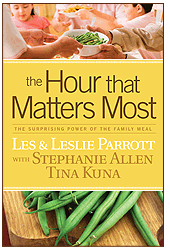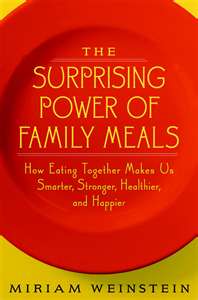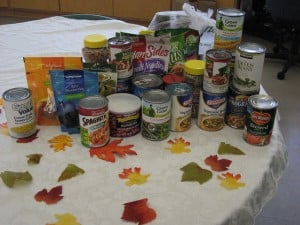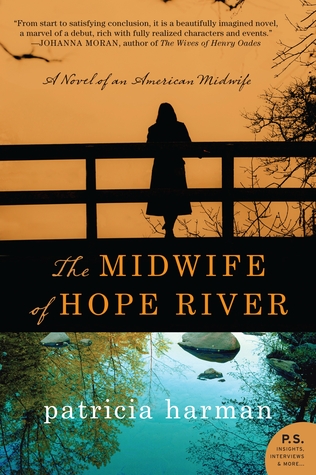Perhaps I’ve been immersed in the world of foodies for too long, but I would’ve expected Les & Leslie Parrott to give a few props to the food movement–beyond pointing out that a movement called Slow Food exists (!)–in their new book, The Hour That Matters Most.
 They could have said more about the qualitative difference of a meal cooked at home as opposed to something brought in from the takeout place. Or talked about WHY eating together–as opposed to just sitting around a table together sans food–is transformative and important. But most of this book is merely a repackaging Parrott’s relationship and communication advice (in other words, how to communicate around the table, which–surprise!–turns out to be quite similar to how we communicate away from the table!) combined with statistics on the importance of family meals that have been presented much more artfully, appealingly, and compellingly elsewhere, namely, Miriam Weinstein’s Surprising Power of Family Meals and Laurie David’s The Family Dinner. Yes, family dinners are very important, and there are lots and lots of well documented reasons what that’s so and lots and lots of statistics from university studies that show you why you really really should have dinners with your family. But you don’t need this book to tell you that.
They could have said more about the qualitative difference of a meal cooked at home as opposed to something brought in from the takeout place. Or talked about WHY eating together–as opposed to just sitting around a table together sans food–is transformative and important. But most of this book is merely a repackaging Parrott’s relationship and communication advice (in other words, how to communicate around the table, which–surprise!–turns out to be quite similar to how we communicate away from the table!) combined with statistics on the importance of family meals that have been presented much more artfully, appealingly, and compellingly elsewhere, namely, Miriam Weinstein’s Surprising Power of Family Meals and Laurie David’s The Family Dinner. Yes, family dinners are very important, and there are lots and lots of well documented reasons what that’s so and lots and lots of statistics from university studies that show you why you really really should have dinners with your family. But you don’t need this book to tell you that.
 In a book about family dinners, I would have liked to have heard at least a few insightful remarks about FOOD. Frankly, I feel it’s kind of unconscionable to bring a book out like this with seemingly no awareness of what is happening in the world of food, from La Cosecha/The Harvest to, oh yes, slaughterhouse workers or the immense and egregious environmental destruction and animal suffering wrought by the food system. It seems like everyone else has at least an inkling that there’s an ethical aspect to eating and food choices, so why not the Parrotts? There’s also no mention of childhood obesity, or of the fact that diet related disease continues to climb in our country. The Parrotts repeat frequently that they don’t want to make you feel guilty, and that they don’t want this to be hard for you to do. So there’s nothing in there that’s going to make anyone uncomfortable or unhappy.
In a book about family dinners, I would have liked to have heard at least a few insightful remarks about FOOD. Frankly, I feel it’s kind of unconscionable to bring a book out like this with seemingly no awareness of what is happening in the world of food, from La Cosecha/The Harvest to, oh yes, slaughterhouse workers or the immense and egregious environmental destruction and animal suffering wrought by the food system. It seems like everyone else has at least an inkling that there’s an ethical aspect to eating and food choices, so why not the Parrotts? There’s also no mention of childhood obesity, or of the fact that diet related disease continues to climb in our country. The Parrotts repeat frequently that they don’t want to make you feel guilty, and that they don’t want this to be hard for you to do. So there’s nothing in there that’s going to make anyone uncomfortable or unhappy.
(Except perverse people like me who think maybe a little discomfort is GOOD FOR US and actually leads to greater joy. But in seriousness, another major problem with the book is that it’s pretty exclusively focused on parents with children at home. It says virtually nothing–nothing that I remember, anyway–about people without children eating together, let alone single people. I happen to be a parent with children at home, but I’m seriously uncomfortable on behalf of readers who don’t. Ugh.)
And although the book is released by Tyndale House, it is, frankly, embarrasingly lite on Christianity. Beyond pointing out the psychological benefits of believing in God–or even just a higher power or cause–(and how that belief can be transmitted round the dinner table), there’s nothing in this book that’s going to offend ANYone, except, of course, people who care about the ethics of eating and, you know, the Bible. At the risk of sounding like a total Bible-thumper (or at least, like a person who’s been trying for the last 6 years to figure out what the Bible says and doesn’t say about food and eating), I’m astounded that the Parrotts could release a book on the family dinner and say almost nothing about all that food and fellowship mean in the life of God’s people, from the manna in the wilderness to the wedding at Cana to the last supper to Acts’ love feasts. And since when does “Christian book” (which, being published by Tyndale House, this is supposed to be) mean vaguely religious feel-good writing in which the topic at hand is in no way approached from a perspective resembling anything that Christianity either is or ever has been?
(but it IS good fodder for Jon Acuff, see Stuff Christians Like #1.)

But maybe worst of all, the parts of the book that actually do address food directly function as little more than a thinly-veiled advertisement for DreamDinners.com. Written in collaboration with the two founders of this meal-prep company–a nationwide “meal-assembly” franchise with over 130 locations nationwide–the book advertises itself as including “never before published recipes” and “expert cooking tips,” but ventures no further than bottled barbecue sauce slow cooker recipes and casseroles using “nonfat pasteurized egg products.” Though the book claims to want to reverse the cultural trend towards “fast and easy” and “microwaved,” its recipes fall firmly within the genre of recipe that exploded in the post WW2 years, namely, the industrial kitchen recipe. And again, because the book is more a repackaging of communication advice than a book about food, they jab at folks who microwave various things for various members of the family but don’t provide a compelling reason WHY you shouldn’t do that or WHY you should make a casserole (or something) instead.
 Bottom line? This book is not worth anyone’s time, and certainly not anyone’s money; it feels to me like a book written pretty nearly exclusively for the purpose of transferring cash from the wallets of readers to those belonging to the authors and publishers. Read The Family Dinner if you want facts plus great pictures and recipes (my review of that is here) and The Surprising Power of Family Meals if you want a more thoughtful commentary on all the compelling data surrounding the importance of family meals (sans pictures and recipes).
Bottom line? This book is not worth anyone’s time, and certainly not anyone’s money; it feels to me like a book written pretty nearly exclusively for the purpose of transferring cash from the wallets of readers to those belonging to the authors and publishers. Read The Family Dinner if you want facts plus great pictures and recipes (my review of that is here) and The Surprising Power of Family Meals if you want a more thoughtful commentary on all the compelling data surrounding the importance of family meals (sans pictures and recipes).
 Tomorrow, we’ll look more closely at some of those statistics on the power of eating together. Meanwhile? Send me a message or leave a comment with YOUR questions and ideas on {food, faith, family; joyful justice & bread of life.} I’ll do my best to address them in upcoming posts. With recipes! And pictures! And joy.
Tomorrow, we’ll look more closely at some of those statistics on the power of eating together. Meanwhile? Send me a message or leave a comment with YOUR questions and ideas on {food, faith, family; joyful justice & bread of life.} I’ll do my best to address them in upcoming posts. With recipes! And pictures! And joy.











